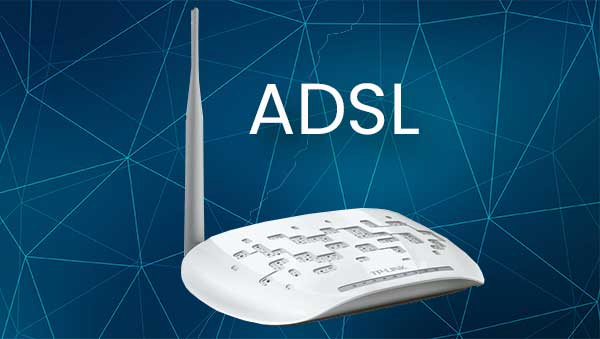A wireless router connected to a modem is a standard setup unless you’re using a gateway. However, there are different modems, cable modems, fiber optic modems, and ADSL modems.
It all depends on our ISP (Internet Service Provider), and what kind of internet connection they provide. That’s why we’re going to discuss what ADSL is, the difference between a modem, router, and a gateway, and how to connect an ADSL modem to a WiFi router.
CONTENTS
What is ADSL?
ADSL (Asymmetric Digital Subscriber Line) is a type of technology that some ISPs use to provide internet access to subscribers. It’s different from cable internet, and it’s different from connecting to the internet via coaxial or fiber optic cables.
ADSL Internet

ADSL transmits data over copper phone lines. The telephone wires are used for calling but they’re also used for transmitting internet access. So, every telephone wire has the same amount of frequency we can use.
Some of it, a tiny bit, is used to transmit the voice when we call people and vice versa, and the other part is used to transmit the signal. Now, this is a complicated process, but it’s been improved so many times that we’ve reached an amazing maximum speed of 24 Mbps (Megabits per second) download speed.
Cable Internet
Cable is a little different because it doesn’t use telephone lines, it uses the cables that bring cable TV to our home. These are known as coaxial cables, and they’re called that way because the conductor and the shield share a geometric axis.
They serve the same function as the telephone lines with ADSL, but they’re different because the coaxial cable has more available bandwidth that’s clean, meaning that we can have higher speeds there.
Fiber Optic Internet

Fiber optic internet has one key difference from the previous types we mentioned. It uses fiber optic cables to transmit the signal. Because these are made of glass and plastic, the analog signal is transmitted as light.
Light speed is the fastest known speed to man. Ergo, fiber optic internet is the fastest available internet out there. So, why do people still use ADSL? Well, it’s cheaper than both the coaxial and fiber optic internet because it uses existing telephone lines, and you get a decent connection.
Modem vs. Router vs. Gateway
Now that we know what ADSL is, and the other mediums that get the internet to our home, we need to understand the differences between modems, routers, and gateways to connect an ADSL modem to a WiFi router.
Modem Functions
The modem works by modulating and demodulating the signal it receives from the wires inside and outside our home. Therefore, it’s called a modem. It turns analog signals coming from a coax cable, fiber optic cable, or telephone line into digital signals and we get internet access from these.
The ADSL modem grabs analog signals from existing telephone lines and turns them into digital signals, i.e. internet. So, we need to connect a router to get wireless access, or if we want to connect over 4 devices to the internet.
Router Functions
The router is usually combined with a modem to establish a network for other devices to use. Implied by its name, it routes connections with its NAT (Network Address Translation) feature to different devices connected to the network.
So, it takes the digital signal the modem provides and transmits it to the entire network based on the final destination it’s supposed to go to. If you type a web address into the browser, it will come to you. If your partner typed it, it will go to their device, etc.
Gateway Functions
Now, gateways are convenient devices because they are a combination of a modem and a router. Instead of having two different devices and cables going in and out of these devices to establish a functional network, we have one device that performs all the functions.
It works as a modem (modulator/demodulator) and a router at the same time. One advantage of having a gateway is that, with most of them, you can disable the routing feature, and just make it an internet connection access point.
Connecting ADSL Modem to WiFi Router
Remember that you don’t need to follow the next step if you’re not using an ADSL modem specifically. If you’re a cable or fiber optic subscriber, then all you need to do is connect the router to the modem, unless you’re using a gateway.
When you’re using a gateway, or you’re a subscriber of cable or fiber optic internet, you need to follow steps specific to those situations, which we’ll probably cover in a different article. So, here’s how to connect an ADSL modem to a WiFi router:
- Before we begin with the settings, make sure that you have all the components ready.
- Both the router and ADSL modem should have an Ethernet cable connecting them at their WAN ports.
- We need to connect our device to one of the LAN ports of the router before turning all the devices on.
- Once we do that, we need to go to the router’s WEB-UI, and to do that, we need to know the specific login for our router.
- Then, we need to adjust the WAN connection. Usually, there’s a WAN section on the left pane of any settings page.
- Once there, we need to change the WAN to PPPoE (Point to Point Protocol over Ethernet) which the ADSL ISPs use.
- You need to enter the username and password your ISP provided into the PPPoE connection section.
- Click Save to apply settings.
- The final step is to do a power cycle of the devices and you’re done.
Recommended reading: ADSL Router Login [A Detailed Guide]
Conclusion
Now we know the differences between cable, fiber optic, and ADSL, and we know the differences between routers, modems, and gateways. Also, we know how to connect an ADSL modem to a WiFi router.
If the configuration you’re trying to establish doesn’t work, it might be best to try it with a different router or a different modem. Finally, you might want to consider contacting your ISP to see if they have any recommendations.

Hey, I’m David. I’ve been working as a wireless network engineer and a network administrator for 15 years. During my studies, I also worked as an ISP field technician – that’s when I met Jeremy.
I hold a bachelor’s degree in network engineering and a master’s degree in computer science and engineering. I’m also a Cisco-certified service provider.
In my professional career, I worked for router/modem manufacturers and internet providers. I like to think that I’m good at explaining network-related issues in simple terms. That’s exactly what I’m doing on this website – I’m making simple and easy-to-follow guides on how to install, set up, and troubleshoot your networking hardware. I also review new network equipment – modems, gateways, switches, routers, extenders, mesh systems, cables, etc.
My goal is to help regular users with their everyday network issues, educate them, and make them less scared of their equipment. In my articles, you can find tips on what to look for when buying new networking hardware, and how to adjust your network settings to get the most out of your wi-fi.
Since my work is closely related to computers, servers, and other network equipment, I like to spend most of my spare time outdoors. When I want to blow off some steam, I like to ride my bike. I also love hiking and swimming. When I need to calm down and clear my mind, my go-to activity is fishing.
